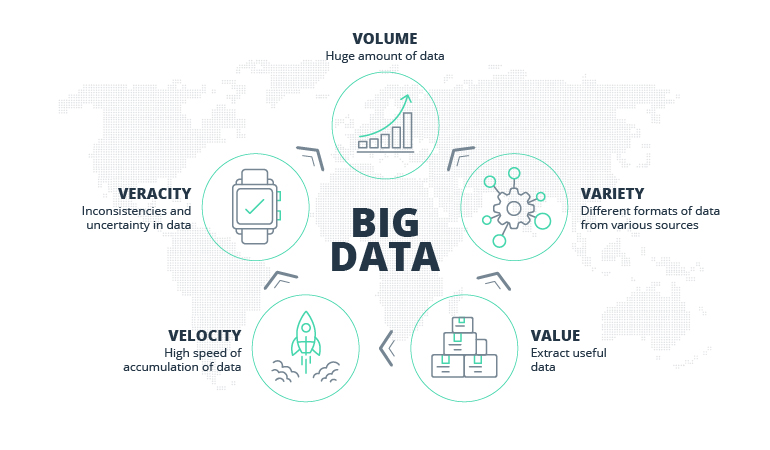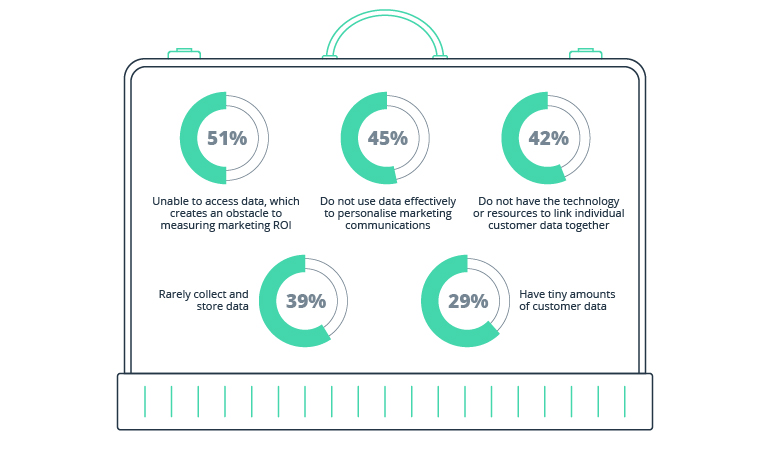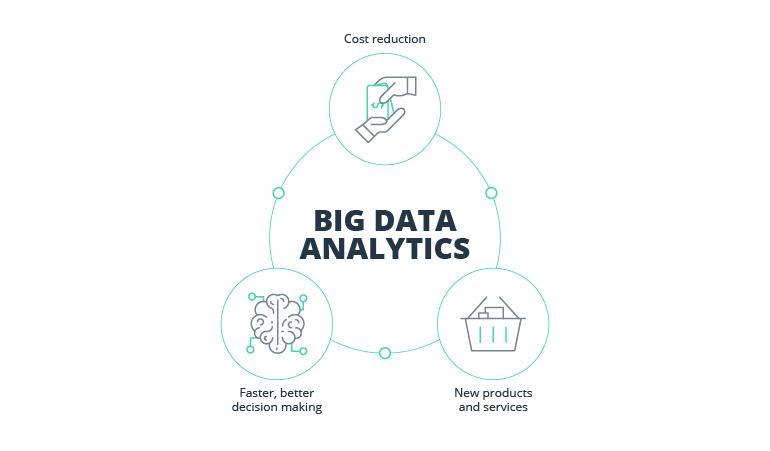In today’s world of eCommerce, data has become the ultimate commodity. The eCommerce sector produces oceans of data on customers’ behavior and purchasing habits. But while some businesses have learned to cut through the tides of data, others are drowning. As data sets get bigger and more complex, traditional data processing tools become inefficient. If you want to stay ahead of the curve in eCommerce, big data is the name of the game.
Using big data in eCommerce can improve your market position and your relationships with customers. By applying proper data analytics, eCommerce brands can predict and manage risks, forecast demand and sales, precisely target their audiences, and optimize supply chains and logistics. Read on to discover more.
How big is big data?
One terabyte is a pretty decent size for a laptop’s internal storage, right? Well, put together one billion well-appointed laptops, and you get a zettabyte of storage. According to an IDC research, we created, copied, and consumed a mind-boggling 59 zettabytes of data in 2020 alone.
The daily influx of new data from customers, employees, and IoT devices can provide businesses with a steady supply of valuable insights. However, this data is raw, and separating the wheat from the chaff is only half the battle. Enter big data analytics with its resources to structure and analyze unimaginable volumes of data.

Source: Datafloq
In the dynamic landscape of eCommerce, big data lets you cater to your customers’ needs and whims, predict customers’ future steps, and build long-lasting relationships. Having loyal customers makes you a successful market player. Just look at Target and Reebok, both of whom launched new loyalty programs to establish a deeper connection with their customers. Amazon is making headway with its Personalize service, allowing customers to add buying recommendations on the fly. All of this is courtesy of big data. The key is to effectively handle its challenges.
The data analysis challenges retailers face
Nothing worthwhile comes easily, and this goes for handling large volumes of unstructured data. To benefit from implementing big data in eCommerce, you need to manage these challenges first:
- Obtaining quality data. If the data you collect is inaccurate or you can’t properly identify its sources, you can extract little to no meaning from it.
- Ensuring privacy and security. Data collection must comply with relevant data protection laws. You also need to ensure the ethical use of collected data and tell your customers how their data will be used. And once you’ve gathered data, you’re obliged to keep it secure on your servers.
- Handling various data formats. The larger the business, the more diverse the data it gathers, generates, and depends on. Unless you’re sponsoring another Tower of Babel, you’ll need to put in place data conformity standards.
- Coping with outdated technology. Artificial intelligence (AI) is advancing quickly, server hardware needs to be upgraded, and IoT sensors are getting more sophisticated. Keeping up with progress on both the software and hardware fronts is crucial for the success of your big data initiative. If you aren’t using machine learning (ML) to analyze your data or using the fastest cloud services to store it, you might already be falling behind in the race.
- Earning your customers’ data. In order to obtain consent for data collection, your business has to give customers something in return: a token of trust and appreciation. This could be a benefit such as a discount, exclusive offer, or preorder option along with the guaranteed security of the customer’s personal information. These favors will make your data pools brim.
- Drawing insights. It’s a fast world we’re living in, and a modern eCommerce business cannot afford errors or delays. Insightful data analytics can help businesses identify problems, but making the right conclusions is equally critical. Use each and every opportunity to listen to your customers. Do they want a faster website and a simpler checkout, or are they ready to leave because you never have that purse in olive green?
- Keeping up with the demographic and life changes. All major changes in people’s lives are reflected in their purchasing habits. It’s important to keep track of the marriages, babies, dogs, and promotions that happen in your customers’ lives to capture the moments when customers’ needs change.
- Overcoming a lack of talent. If you decide to build big data analytics tools from scratch, in-house development can be challenging and pricey. Finding experts with experience in eCommerce is tough, but hiring a good contractor will pay off in the long run.
- Transforming data into actions. Collecting data is one thing; analyzing that data, getting insightful and valuable information from it, and immediately acting on that knowledge is totally different. Your business needs to take action while data is relevant.
Source: Linnworks
Adopting big data for your business can be challenging and sometimes overwhelming. Let’s see what makes it worth the trouble.
8 perks of using big data in eCommerce
Like any other aspect of running an eCommerce business, working with big data has its challenges — but the benefits definitely outweigh them. When your company adopts big data, you’ll be equipped to:
Predict sales
Social listening tools monitor social media and pick up details of conversations relevant to your eCommerce business. You’ll receive insights into what brands and goods are gaining momentum and which are starting to stall. You’ll then be able to adjust your inventory accordingly, avoid losses, and increase sales.
Optimize supply chains and logistics
When you have a strong understanding of customer demand, it’s easier to plan your supply. Sales data analysis can pinpoint exact quantities of items to purchase, while data processed from GPS trackers can help you plan optimal routes and delivery time slots.
Define buyer personas
Retail businesses can learn a lot about their customer bases by diving deeper into users’ interactions with their websites, social media platforms, and other outlets. This creates opportunities for better-tailored marketing campaigns and exclusive offers that appeal to customers’ values and buying preferences.
Personalize the customer experience
When you collect data about your customers, you can use AI and ML to track their behavior in real time, yielding valuable insights. Armed with these insights, you can create a personalized space with custom greetings, suggestions, email messages, locale-based settings such as currency and language, and special offers. This is an improvement your loyal customers will surely appreciate.
Retain customers by improving service
It always costs more to find new customers than to keep loyal ones. And the quality of service is a significant factor in retention. Big data will help you compile comprehensive customer profiles, which can be of great value to service teams when interacting with customers.
Fine-tune pricing
With big data, you can promptly adjust pricing based on customer demand and market competition. You can also automate price adjustments thanks to various tools so your employees can focus on creative tasks.
Manage risks and prevent fraud
Big data services allow companies to monitor transactions as they occur and identify potentially fraudulent patterns of behavior using predictive/prescriptive analysis. The same methods can be used to detect and block bot activity in marketing campaigns.
Drive even more sales
Market Basket Analysis is a technique that tells retailers which goods are likely to be purchased together. This technique is essential for creating real-time recommendations that are almost impossible to refuse. A similar strategy can prevent customers from canceling or not completing their purchases at the final stages of the sales funnel. In late 2019, the Baymard Institute reported a 69.57% cart abandonment rate among shoppers. Powered by big data, alternative recommendations and remarketing could close some of those sales.
Source: NASSCOM Insights
Next, let’s learn how big data helps businesses grow and see real cases of successful big data implementation from some of the world’s most prominent retailers.
Stories of Success
In 2017, Walmart, a multinational retail corporation with over 2.2 million employees worldwide, committed to a new phase in its digital transformation. The company started building the largest private cloud system in the world, capable of handling 2.5 petabytes of transactional data per hour. This system uses big data aggregation and analysis to improve checkout speeds, manage supply chains, optimize product selection, and personalize the customer experience.
Starbucks is another company that has successfully harnessed big data. With the assistance of big data, the world-famous coffee chain studies its customers’ buying habits, tracks customers’ locations and learns about current trends in the industry — all to predict the performance of future shops. Starbucks also uses customer information to engage with returning customers, cultivating loyalty, and providing an outstanding personalized experience.
The storm is here
One of the key findings of IDC’s Global DataSphere forecast from late 2019 reads:
“The amount of data created over the next three years will be more than the data created over the past 30 years, and the world will create more than three times the data over the next five years than it did in the previous five.”
2020 rampaged through those predictions. The COVID-19 pandemic has pushed more businesses, customers, and employees online than we could ever have expected, creating an unprecedented flow of data. Those who are able to collect it, analyze it, and evolve to meet customers’ needs will inevitably prevail. The question of implementing a big data solution no longer starts with an uncertain “if” — it’s a resounding, urgent “when.”
Read more: Patience Zero – Restlessness of the Modern Consumer

